Research News
-
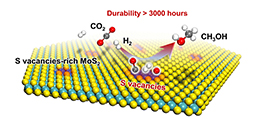 03 23, 2021Novel Catalyst Boosts Hydrogenation of CO2 to Methanol: Higher Activity, Selectivity and StabilityResearchers achieved hydrogenation of CO2 to methanol at low temperature and with high efficiency.
03 23, 2021Novel Catalyst Boosts Hydrogenation of CO2 to Methanol: Higher Activity, Selectivity and StabilityResearchers achieved hydrogenation of CO2 to methanol at low temperature and with high efficiency.
The hydrogenation of carbon dioxide (CO2) to methanol using a renewable energy-based "green hydrogen" source is one of the promising methods to alleviate energy crisis and achieve the goal of carbon neutrality.
Recently, a group led by Prof. DENG Dehui from the Dalian Institute of Chemical Physics (DICP) of the Chinese Academy of Sciences (CAS), in collaboration with Prof. WANG Ye from the College of Chemistry and Chemical Engineering, Xiamen University, for the first time, achieved hydrogenation of CO2 to methanol at low temperature and with high efficiency.
The study was published in Nature Catalysis on March 22.
Traditional metal oxide catalysts for CO2 to methanol reaction typically require a high temperature of above 300 ℃, which causes undesired reverse water-gas shift (RWGS) side reactions, and thus produces a large amount of CO as the by-product.
Introduction of transition metal components onto metal oxides can promote the activation of H2, thereby reducing the reaction temperature, but this also facilitates excessive hydrogenation of CO2 to CH4, leading to lower methanol selectivity.
Sulphur vacancies-rich MoS2 as catalyst for the hydrogenation of CO2 to methanol (Image by HU Jingting and YU Liang)
In this study, the sulfur vacancy-rich few-layered MoS2, as the catalyst, could simultaneously activate and dissociate CO2 and H2 at low temperatures and even at room temperature, thereby facilitating the hydrogenation of CO2 to methanol with high activity and selectivity.
In situ characterizations combined with theoretical calculations demonstrated that the in-plane sulfur vacancies on MoS2 were the active centers for catalyzing the highly selective hydrogenation of CO2 to methanol.
In addition, the researchers found that the RWGS reaction and excessive hydrogenation of methanol to CH4 were effectively suppressed. At 180 ℃, the methanol selectivity could reach 94.3% at a CO2 conversion of 12.5%; this result was better than that obtained with the commercial Cu/ZnO/Al2O3 catalyst and previously reported catalysts.
The activity and selectivity were steadily maintained for over 3000 hours over the MoS2 catalyst, making it a promising candidate for industrial applications.
"This work reveals the potential of in-plane vacancies in two-dimensional materials for catalysis and provides a novel strategy for the development of new catalysts to be used in CO2 hydrogenation," said Prof. DENG.
This work was highlighted in a News & Views article in Nature Catalysis. Prof. Felix Studt from Karlsruhe Institute of Technology appraised it as an amazing and interesting work, which may bring large efficiency gains in CO2 conversion to methanol. (Text by HU Jingting and YU Liang) -
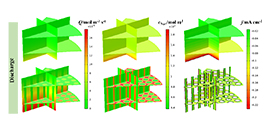 03 22, 2021Novel Cathode Designed for High-performance Sodium Ion BatteriesScientists designed and optimized a low-tortuosity and high-areal-capacity cathode for high rate and ultra-stable SIBs via non-solvent induced phase separation derived method.
03 22, 2021Novel Cathode Designed for High-performance Sodium Ion BatteriesScientists designed and optimized a low-tortuosity and high-areal-capacity cathode for high rate and ultra-stable SIBs via non-solvent induced phase separation derived method.
Due to their large-scale energy storage, sodium ion batteries (SIBs) are a promising alternative to lithium-ion batteries (LIBs). However, it's challenging to develop high-energy and high-power SIBs due to the greater atomic mass and larger ionic radius.
Electrode architecture design with high mass loading of active materials is a more straightforward strategy to achieve high energy. It can increase the percentage of active materials and consequently energy density at device/cell levels.
Recently, a research group led by Prof. LI Xianfeng and Dr. ZHENG Qiong from the Dalian Institute of Chemical Physics (DICP) of the Chinese Academy of Sciences (CAS) designed and optimized a low-tortuosity and high-areal-capacity cathode for high rate and ultra-stable SIBs.
The results were published in Advanced Energy Materials on March 18.
Schematics illustrating the ion transport pathways in diverse electrodes (Image by LV Zhiqiang and YUE Meng)
The researchers reported a low-tortuosity, finger-like composite electrode with ultra-high mass loading based on nonsolvent-induced phase separation method, which could offer well-pleasing electron/ion transport pathway and relatively low battery resistance.
Benefiting from the structural advantages, they achieved the as-prepared electrode with ultra-high mass loading (60 mg/cm2) and areal capacity (4.0 mAh/cm2). Even at a high rate of 10 C, the areal capacity remains 1.0 mAh/cm2.
The researchers also illustrated the homogeneous Na+ distribution, gentle and uniform local current density and polarization inside the as-prepared electrode.
Combining numerical simulations and experiments, they revealed that the low-tortuosity architecture could contribute to an impressive ion transport capability and consequently significant improvements in electrochemical performance.
This study exhibits a prospective solution for the design and optimization of the low-tortuosity electrodes with ultra-high mass loading, which opens a new door for developing advanced SIBs with high energy/power density.
This work was supported by the Strategic Priority Research Program of the Chinese Academy of Sciences, the National Natural Science Foundation of China, Youth Innovation Promotion Association of CAS, and the Dalian National Laboratory Cooperation Fund, CAS. (Text by LV Zhiqiang and YUE Meng) -
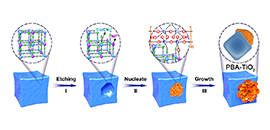 03 17, 2021Janus Nanoreactor Designed for Bifunction of Photocatalytic Water Oxidation/reduction
03 17, 2021Janus Nanoreactor Designed for Bifunction of Photocatalytic Water Oxidation/reduction
Janus structure is composed of two or more components with different (usually opposite) physical and chemical properties. Janus nanoparticles possess multiple surface structures that are anisotropic in shape, composition, and surface chemistry.
Janus nanoreactors have been applied in the fields like catalysis, biomedicine, as well as energy storage and conversion. However, it remains a challenge to construct Janus nanoreactors with stable interfacial structure.
Recently, a research team led by Prof. LIU Jian from the Dalian Institute of Chemical Physics (DICP) of the Chinese Academy of Sciences, in collaboration with Prof. HU Ming from East China Normal University, reported a novel and simple strategy for the synthesis of dual-component Janus nanoreactor with asymmetric structure to realize bifunction of photocatalytic water oxidation/reduction.
This work was published in Advanced Science on Feb. 16.
A: schematic illustration of the synthetic strategy for the PBA–TiO2 Janus nanoreactor, B: TEM images of the as-prepared PBA-TiO2 Janus nanoreactors C: comparison of photocatalytic H2 evolution and O2 evolution rate of TiO2, PBA, PBA–TiO2 Janus nanoreactors and PBA–TiO2 (mix) samples under light irradiation (Image by SHI Chunjing)
"We mimics the concepts of compartmentalization used by nature to design PBA-TiO2 Janus photocatalysts for coordinating incompatible chemical transformations," said Prof. LIU.
In the synthesis process, the partial dissociation of the PBA cube was induced by mild etching. The unsaturated metal sites on the PBAs could form the chemical bond with oxygen ions and Ti4+, inducing heterogeneous nucleation of TiOx on the surface of the PBA single crystals.
Free-standing flowers assembled by TiO2 nanoflakes took root in the PBA single crystals. The PBA-TiO2 Janus nanoreactor gradually emerged and the asymmetric dual-components of nanoreactor possessed a synergistic effect due to the presence of the interfacial structure.
The forming interfacial structure could promote the fast charge transport and effectively inhibit the photogenerated electron and hole recombination. The photocatalytic activity of PBA-TiO2 Janus nanoreactor for water oxidation/reduction was significantly higher than that of pure TiO2 and PBA catalysts.
The above work was supported by the National Natural Science Foundation of China, and Dalian National Laboratory for Clean Energy (DNL) Cooperation Fund, Chinese Academy of Sciences. (Text by SHI Chunjing) -
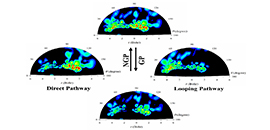 03 17, 2021Scientists Reveal Nature of Geometric Phase Effects in Ultracold Chemical ReactionsScientists unveiled the nature of GP effects in the ultracold chemical reaction for the first time.
03 17, 2021Scientists Reveal Nature of Geometric Phase Effects in Ultracold Chemical ReactionsScientists unveiled the nature of GP effects in the ultracold chemical reaction for the first time.
A degeneracy or conical intersection occurs in many of the experimentally relevant ultracold (T < 10-3 kelvin, 1 kelvin = -273.15°C) reaction systems, resulting in a geometric phase (GP) that modifies many of the ultracold reaction rates.
Due to its potential application in controlling ultracold chemistry, the so-called GP effects have attracted lots of attention. However, the mechanism of GP effects in ultracold reaction process remains uncleared.
Recently, a research ream led by Prof. ZHANG Dong Hui from the Dalian Institute of Chemical Physics (DICP) of the Chinese Academy of Sciences unveiled the nature of GP effects in the ultracold chemical reaction for the first time.
Their results were published in The Journal of Physical Chemistry Letters on Feb. 26.
Mechanistic insights into Uultracold chemical reactions under the control of the geometric phase (Image by HUANG Jiajun)
The researchers calculated the time-independent scattering wave function of the ultracold O + OH → H + O2 reaction using the newly developed time-dependent wave packet (TDWP) dynamical method.
The analysis of the total scattering wave function revealed the nature of the quantum interference and associated GP effects in this ultracold reaction process for the first time. And this wave function analysis can be generalized to other ultracold reactions that contain a conical intersection.
This study offers a new way for providing mechanistic insight for the dynamics and control of ultracold chemical reactions. (Text by HUANG jiayu) -
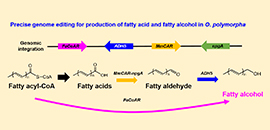 03 10, 2021Novel Genetic Tools Make Possible Efficient and Precise Genome Editing in Methylotrophic YeastsResearchers achieved efficient genome editing in methylotrophic yeasts.They developed novel genetic tools for precise genome editing in Ogataea (Hansenula) polymorpha by enhancing high homologous recombination (HR) rates, and revealed a strong competition between HR and non-homology end joining (NHEJ). With this efficient tool, O. polymorpha was harnessed for the first production of fatty alcohols from both glucose and methanol.
03 10, 2021Novel Genetic Tools Make Possible Efficient and Precise Genome Editing in Methylotrophic YeastsResearchers achieved efficient genome editing in methylotrophic yeasts.They developed novel genetic tools for precise genome editing in Ogataea (Hansenula) polymorpha by enhancing high homologous recombination (HR) rates, and revealed a strong competition between HR and non-homology end joining (NHEJ). With this efficient tool, O. polymorpha was harnessed for the first production of fatty alcohols from both glucose and methanol.
Ogataea (Hansenula) polymorpha, a representative methylotrophic yeast, can efficiently assimilates methanol, and thus is considered as a promising chassis host for efficient methanol biotransformation.
However, difficulties in convenient and precise genome editing in O. polymorpha limits its metabolic engineering toward industrial application.
Recently, a research group led by Prof. ZHOU Yongjin from the Dalian Institute of Chemical Physics of the Chinese Academy of Sciences achieved efficient genome editing in methylotrophic yeasts.
They developed novel genetic tools for precise genome editing in O. polymorpha by enhancing high homologous recombination (HR) rates, and revealed a strong competition between HR and non-homology end joining (NHEJ).
With this efficient tool, O. polymorpha was harnessed for the first production of fatty alcohols from both glucose and methanol.
This work was published in iScience on Feb. 9.
Recombination machinery engineering for precise genome editing in methylotrophic yeast Ogataea polymorpha (Image by GAO Jiaoqi)
CRISPR/Cas9 system was constructed and optimized by fine regulation of Cas9 and expression of sgRNA, which achieved efficient genome edition with positive rates up to 90% Then the dynamically regulation of key gene KU80 in NHEJ pathway and enhanced expression of HR-related proteins (Rad51, Rad52, Sae2) increased HR rates to 60~70%.
"This HR up-regulated systems has been applied for scarless gene deletion, homologous integration of large fragments and in vivo assembly of multiple fragments, which enables the first production of fatty alcohols in O. polymorpha," said Prof. ZHOU.
This study was supported by National Natural Science Foundation of China, Dalian Science and Technology Innovation Funding, DMTO and BioChE-X Research Grant of DICP, CAS. (Text by GAO Jiaoqi) -
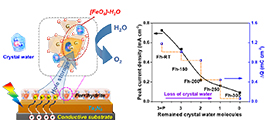 03 10, 2021Study Unveils Hydration Structure of Ferrihydrite for Hole Storage in Photoelectrochemical Water OxidationResearchers from DICP unveiled the hydration structure of ferrihydrite for hole storage based on tantalum nitride photoanode system.
03 10, 2021Study Unveils Hydration Structure of Ferrihydrite for Hole Storage in Photoelectrochemical Water OxidationResearchers from DICP unveiled the hydration structure of ferrihydrite for hole storage based on tantalum nitride photoanode system.
Photoelectrochemical (PEC) water splitting is an ideal approach for renewable solar fuel production. Tantalum nitride (Ta3N5) has a theoretical solar to hydrogen conversion efficiency of 15.9%, but it is not stable in the highly oxidative environment of water oxidation.
Ferrihydrite (Fh) could be used in modifying Ta3N5 photoanode for highly stable water oxidation reaction. However, the intrinsic structure responsible for the hole storage function for Fh remains unclear.
Recently a research team led by Prof. LI Can from the Dalian Institute of Chemical Physics (DICP) of the Chinese Academy of Sciences unveiled the hydration structure of ferrihydrite for hole storage based on tantalum nitride photoanode system.
Their results were published in Angew. Chem. Int. Ed. and selected as hot paper.
Unveiling the hydration structure of ferrihydrite for hole storage in photoelectrochemical water oxidation (Image by WANG Pengpeng and SHI Jingying)
The researchers demonstrated that the irreversible and gradual loss of crystal water molecules in Fh led to the weakening of the hole-storage function, accompanied with the arrangement of inner structure units.
They proposed a structure evolution of the dehydration process and identified the primary active structure of Fh for HSL as the [FeO6] polyhedral units bonding with two or three molecules of crystal water.
Moreover, they found that with the successive loss of chemical crystal water, the coordination symmetry of [FeO6] hydration units underwent mutation and a more ordered structure was formed, causing the difficulty for accepting photogenerated holes as a consequence.
This study provides a new avenue for the rational design of efficient and stable solar water splitting devices based on interfacial modification strategies.
The research was supported by the National Natural Science Foundation of China and the Ministry of Science and Technology of China. (Text by WANG Pengpeng and SHI Jingying)